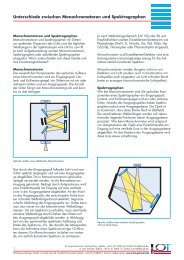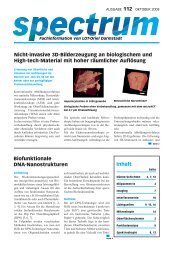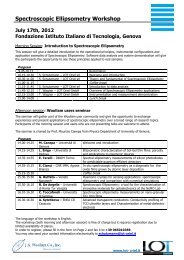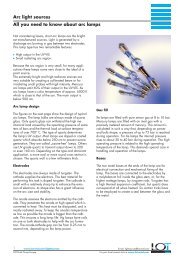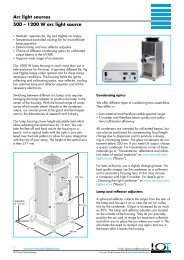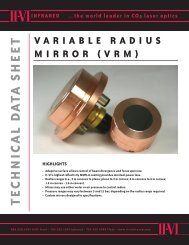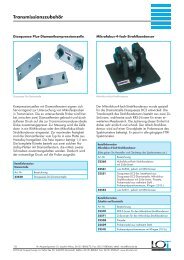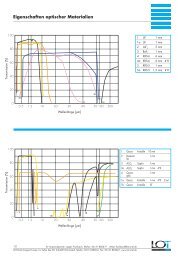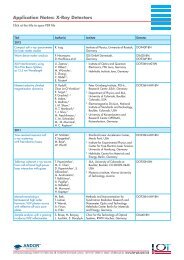Astrophotography with next generation EMCCD ... - L.O.T.-Oriel
Astrophotography with next generation EMCCD ... - L.O.T.-Oriel
Astrophotography with next generation EMCCD ... - L.O.T.-Oriel
Create successful ePaper yourself
Turn your PDF publications into a flip-book with our unique Google optimized e-Paper software.
<strong>Astrophotography</strong> <strong>with</strong> <strong>next</strong> <strong>generation</strong> <strong>EMCCD</strong> cameras<br />
Carsten Dosche (October 2009)<br />
Introduction<br />
<strong>Astrophotography</strong> has a long tradition reaching back<br />
nearly to the beginning of photography itself. However,<br />
it has been restricted to professional users und<br />
few amateurs as it required expensive equipment and<br />
special handling of the chemical films. Since the early<br />
90’s, the development of CCD and CMOS sensors has<br />
revolutionized amateur astrophotography. These new<br />
sensors offered not only superior sensitivity, but also,<br />
combined <strong>with</strong> the parallel development of computer<br />
techniques, the benefits of electronic picture processing<br />
and automated star tracking for the still long exposure<br />
times. With the <strong>EMCCD</strong> camera concept a new<br />
<strong>generation</strong> of sensors has been developed providing<br />
sensitivity down to the single photon regime. <strong>EMCCD</strong>s<br />
nowadays are widely used for single molecule spectroscopy<br />
and professional astronomy, but can also be<br />
beneficial for amateur astrophotography.<br />
General CCD <strong>Astrophotography</strong><br />
Digital astrophotography is always limited by the S/N<br />
ratio which can be achieved <strong>with</strong> the detection system.<br />
The sensitivity of a CCD detector is mainly limited by<br />
quantum yield and dark current of the chip.<br />
Generally, the photon quantization and the limited<br />
quantum yield (not every photon will generate a<br />
charge on the chip) cause photon noise. For normal<br />
applications this will never be a problem as the number<br />
of detected photons is always much higher than the<br />
photon noise floor. However in low light applications<br />
such as astrophotography this will become relevant if<br />
only few photons are detected. Moreover, there is an<br />
additional noise source caused by the chip electronics,<br />
namely dark current of the chip and the noise related to<br />
it. To overcome this noise problem in astrophotography<br />
long exposure times are required in order to generate<br />
as much signal as possible above the noise floor.<br />
In principle, this can achieved either by increasing<br />
the exposure time for a single frame or by acquiring<br />
multiple exposures. The effect of increasing the total<br />
exposure time by stacking many exposures is shown<br />
in Fig. 1. A single frame is quite noisy. After sampling<br />
5 or 50 frames, respectively, the enhancement of the<br />
S/N ratio is obvious.<br />
In order to obtain an optimal S/N ratio before read<br />
out, the single frame exposure time usually is increased<br />
until the full dynamic range of the CCD chip is used.<br />
These long exposure times, however, give rise to the<br />
need for sophisticated guiding procedures to ensure<br />
an adequate long term tracking of the object in focus.<br />
Therefore it would be desirable to acquire many short<br />
Application Note<br />
exposures instead of one long exposure. However, for<br />
conventional CCD cameras this is not possible. Because<br />
the direct signal from the CCD chip is not high<br />
enough to be processed by the A/D converter, it has to<br />
be pre amplified. The pre amplifier, like all electronic<br />
devices, causes noise which is usually called the read<br />
out noise. The signal from the CCD chip must exceed<br />
this read out noise, elsewhere any signal which does<br />
not exceed the read out noise will be disrupted in the<br />
pre amplifying process. Normally, the only solution is<br />
to increase the exposure time until enough signal is<br />
gathered on the CCD chip.<br />
A technical solution for this dilemma has been invented<br />
<strong>with</strong> the <strong>EMCCD</strong> cameras. Here the signal is amplified<br />
by an EM gain register directly on the chip before<br />
read out. This provides the possibility to make shorter<br />
exposures <strong>with</strong>out loosing information to the read out<br />
noise. The effect of the EM gain is demonstrated in<br />
Fig. 2. In the gain off condition, even after stacking<br />
30 exposures the noise reduction is not sufficient for the<br />
picture processing of weak nebular structures or faint<br />
stars. With the EM gain set to 200, this is no problem<br />
and even some parts of the very weak nebular halo<br />
become visible.<br />
<strong>Astrophotography</strong> using the Luca <strong>EMCCD</strong><br />
Platform<br />
<strong>EMCCD</strong> cameras are still exclusively available for<br />
scientific applications. Apart from the cost factor,<br />
the commonly used <strong>EMCCD</strong> camera systems are not<br />
suitable for amateur astronomy due to weight, power<br />
consumption and computing power requirements for<br />
a high end PC system including a PCI card is needed.<br />
With the Luca <strong>EMCCD</strong> platform from Andor Technology<br />
an <strong>EMCCD</strong> system has been developed which meets<br />
the requirements of amateur astrophotography like USB<br />
connection of the camera, low weight and a prize in<br />
the area of other high end CCD cameras commonly<br />
used for astrophotography.<br />
The Luca <strong>EMCCD</strong>s are available in two versions,<br />
the Luca-S <strong>with</strong> a 658 x 496 Pixel chip and 10 µm<br />
pixel size and the Luca-R incorporating a 1004 x<br />
1002 pixel chip and 8 µm pixel size. The camera<br />
system is equipped <strong>with</strong> a 14 bit A/D converter. This<br />
digitization depth is sufficient as the full pixel capacity<br />
is 26,000 electrons. The weight of about 600 g is<br />
in the range of large commonly used eyepieces and<br />
therefore acceptable for standard mountings. The CCD<br />
chip is thermoelectrically cooled to -20°C in order to<br />
reduce dark current and electron noise. For <strong>EMCCD</strong><br />
sensors this is essential as the thermal noise will also be<br />
LOT-<strong>Oriel</strong> Group Europe. Im Tiefen See 58. D-64293 Darmstadt. phone: +49/6151/8806-0. fax: +49/6151/896667. www.lot-oriel.com/ccd
<strong>Astrophotography</strong> <strong>with</strong> <strong>next</strong> <strong>generation</strong> <strong>EMCCD</strong> cameras<br />
Carsten Dosche (October 2009)<br />
magnified by the EM register. Nevertheless, the power<br />
consumption is below 20 W and the camera could be<br />
driven by car battery if necessary. Although a powerful<br />
computer system is recommended for obtaining<br />
the full performance of the system, a small netbook<br />
equipped <strong>with</strong> an Intel Atom processor as available<br />
since 2008 is completely sufficient to drive the camera<br />
on the field. The camera comes <strong>with</strong> a C-mount connection<br />
and can be easily attached to any telescope using<br />
the standard C-mount adapters to M42, T2 or 1.25”<br />
connectors. The camera has a relatively short backfocus<br />
and therefore can be used <strong>with</strong> most telescopes<br />
<strong>with</strong>out modification of the focal path.<br />
When using a Luca <strong>EMCCD</strong> camera for astrophotography,<br />
some points have to be taken into account. The<br />
Luca <strong>EMCCD</strong> cameras have been invented for microscopy<br />
applications. Thus, long term exposures in the<br />
range up to 60 sec have not been in focus of development.<br />
Although the <strong>EMCCD</strong> chip is free of hot pixels<br />
for exposure times below 1 sec or EM gain-off conditions,<br />
by using long time exposure every “warm” pixel<br />
will be magnified by the EM gain register and appears<br />
as hot pixel in the image. The same is true for every<br />
weak chip inhomogeneity which will also be amplified.<br />
Therefore for every gain-exposure time combination a<br />
dark frame has to be collected. Luckily the chip cooling<br />
works very accurate and thus this procedure has to<br />
be performed only once. In order to obtain noise free<br />
dark frames an average stack of about 100 frames<br />
should be taken and saved as 16 bit Tiff file. When<br />
needed it can be loaded as background image for<br />
acquisition by using the “arithmetic operations” function<br />
of the camera control software Solis. The second<br />
point is about exposure time. Although the camera<br />
appears very sensitive, it does not generate photons,<br />
it just prevents weak signals from being wiped out by<br />
the read out process. Thus the single exposure time can<br />
be reduced <strong>with</strong>out loosing information. However, the<br />
photon noise is amplified as well as the signal itself.<br />
Therefore the total exposure time has to be the same as<br />
for conventional CCDs <strong>with</strong> comparable quantum yield<br />
to obtain an adequate S/N ratio. Only the exposure<br />
time for the sub frames can be significantly lower.<br />
Finally, for astrophotography the Luca-S has relatively<br />
large pixels and a small field of view. The latter problem<br />
can be easily managed by making mosaics. For<br />
the pixel size, normally the focal length of the telescope<br />
has to be matched to the pixel size. For 10 µm pixels<br />
this would inquire that a focal length larger than 1<br />
m should be used. For smaller focal lengths the pictures<br />
will be undersampled what means that stars are<br />
not longer projected as a Gaussian profile. Here the<br />
Application Note<br />
Drizzle algorithm which was originally developed to<br />
enhance the quality of Hubble Telescope pictures can<br />
be used. Details can be found on the webpage www.<br />
stsci.edu/hst/wfpc2/analysis/drizzle.html. With this<br />
method the resolution of the pictures can be enhanced<br />
by a factor of 2 <strong>with</strong>out loosing S/N ratio.For this<br />
method a relatively large number of single frames is<br />
required, for each frame the object displaced on a sub<br />
pixel scale. Here the exposure technique applied to the<br />
<strong>EMCCD</strong>s, namely making many short exposed frames<br />
is ideal for using the Drizzle technique. The effect of<br />
the Drizzle algorithm can be seen in Fig. 3, the upper<br />
picture stacked conventionally, scaled by a factor of 2<br />
and linearly interpolated, the lower stacked by using<br />
the Drizzle function.<br />
Field Tests<br />
For testing the suitability of the Luca <strong>EMCCD</strong> platform<br />
for astrophotography a Luca-S was used in combination<br />
<strong>with</strong> telescopes of different focal lengths between<br />
0.43 m and 6 m. Most exposures were performed on<br />
a not modified commercial EQ6 mounting under mid<br />
European near city conditions. For the <strong>generation</strong> of<br />
colour pictures dichroic filter sets were used, broadband<br />
filters <strong>with</strong> ~75 nm bandpass for red, green<br />
and blue (center wavelengths 460 nm, 530 nm and<br />
650 nm) and narrow band filters <strong>with</strong> 8 nm bandpass<br />
for the SII, Hα, OIII and Hβ bands. Raw exposure series<br />
were taken in the kinetic mode, exported as 16 bit<br />
Tiff files and processed <strong>with</strong> the software Fitswork and<br />
Deepsky Stacker. For most applications, stacking of<br />
25-50 frames was necessary to obtain a S/N ratio of<br />
>500, which is absolutely sufficient for generating high<br />
quality pictures. The EM gain was set to 200.<br />
Galaxies and Globular Clusters<br />
Galaxies and Globular Clusters have in common that<br />
they emit a continuous spectrum what renders the use<br />
of narrow band filtering useless. Apart from “near” galaxies<br />
like the Andromeda Galaxy M31 these objects<br />
are relatively small and require a focal length of about<br />
1 m. For globular clusters exposure times between 5<br />
and 10 sec appeared to be useful. Longer exposure<br />
times resulted in burn out of the centres. For galaxies<br />
exposure times of 20 sec were needed to ensure a sufficient<br />
use of the dynamic range of the camera.<br />
A special issue is represented by dark and reflection<br />
nebulas like the Iris Nebula NGC 7023. These objects<br />
require a very dark sky background and cannot be<br />
taken successfully from city sites. However, under dark<br />
sky conditions the dynamic of the Luca-S is sufficient for<br />
these faint objects.<br />
LOT-<strong>Oriel</strong> Group Europe. Im Tiefen See 58. D-64293 Darmstadt. phone: +49/6151/8806-0. fax: +49/6151/896667. www.lot-oriel.com/ccd
<strong>Astrophotography</strong> <strong>with</strong> <strong>next</strong> <strong>generation</strong> <strong>EMCCD</strong> cameras<br />
Carsten Dosche (October 2009)<br />
Galactic Nebulas<br />
Our galaxy bears a large number of diffuse gas clouds<br />
like the Omega or the Eagle Nebula, which consist<br />
mainly of hydrogen, sometimes also oxygen and<br />
sulphur. Here the use of narrow band filters greatly<br />
enhances the contrast. Especially the high sensitivity of<br />
the Luca S in the red spectral region is beneficial for<br />
the detection of the hydrogen Hα band (656 nm) and<br />
the usually weak SII band (675 nm). As these nebulas<br />
require mostly large fields of view and short focal<br />
lengths, the Drizzle method can readily applied and<br />
gives excellent results. The same is true for super nova<br />
remnants like the Veil Nebula NGC 6992. Exposure<br />
times varied from 5 sec to up to 30 sec.<br />
Planetary Nebulas<br />
Apart from some nearby representatives such as the<br />
Dumbbell Nebula M27, planetary nebulas display a<br />
high brightness but are very small. Therefore very long<br />
focal lengths exceeding 3 m are required. This causes<br />
severe problems as accurate guiding becomes increasingly<br />
difficult <strong>with</strong> growing focal length. In addition, air<br />
disturbances from the atmosphere, the “seeing”, also<br />
has increasing impact on the picture quality. The best<br />
way to conquer these two problems is to reduce the<br />
exposure time as far as possible. Here the advantages<br />
of the <strong>EMCCD</strong>s turn the Luca-S into the ideal detection<br />
system for planetary nebulas. Even for focal lengths of<br />
up to 6 m, good results can be achieved at exposure<br />
times around 2 sec. However, this short exposure time<br />
allows taking 100-500 single exposures. This already<br />
marks the domain where lucky imaging starts being<br />
useful for improving the picture quality. Usually only 10<br />
% out of one exposures series taken at 6 m focal length<br />
could be used for further processing.<br />
Planets<br />
Due to the high frame rate of 30 fps, the Luca-S is also<br />
suitable for lucky imaging of planets and the moon.<br />
For the very bright planet Jupiter it can even operated<br />
<strong>with</strong> gain off. Usually a set of 500 frames is sufficient<br />
to obtain a stacked image where the S/N ratio is good<br />
enough for image processing.<br />
Summary<br />
The Luca-S can be used as a universal workhorse<br />
system for various applications in amateur astronomy.<br />
Hereby the possible use of the camera is not just limited<br />
to imaging. It can also be used for spectroscopy or<br />
variable star photometry, applications gaining increasing<br />
importance even in amateur astronomy.<br />
Application Note<br />
Contact<br />
Dr. Carsten Dosche<br />
Habichtweg 1<br />
14469 Potsdam<br />
Germany<br />
E-Mail: carsten@dosche.de<br />
Web: http://junior-ccd.fn-f.de<br />
www.naa.net<br />
LOT-<strong>Oriel</strong> Group Europe. Im Tiefen See 58. D-64293 Darmstadt. phone: +49/6151/8806-0. fax: +49/6151/896667. www.lot-oriel.com/ccd
<strong>Astrophotography</strong> <strong>with</strong> <strong>next</strong> <strong>generation</strong> <strong>EMCCD</strong> cameras<br />
Carsten Dosche (October 2009)<br />
1a<br />
1b<br />
1c<br />
Fig. 1: Effect of stacking 1 (1a), 5 (1b) and 50 (1c) 20 sec exposures of the<br />
Dumbbell Nebula Hα band<br />
Application Note<br />
LOT-<strong>Oriel</strong> Group Europe. Im Tiefen See 58. D-64293 Darmstadt. phone: +49/6151/8806-0. fax: +49/6151/896667. www.lot-oriel.com/ccd<br />
2a<br />
2b<br />
Fig. 2: 30 frame stacks of 10 sec exposures of the Dumbbell Nebula Hα band<br />
<strong>with</strong> EM gain off (2a) and EM gain set at 200 (2b)
<strong>Astrophotography</strong> <strong>with</strong> <strong>next</strong> <strong>generation</strong> <strong>EMCCD</strong> cameras<br />
Carsten Dosche (October 2009)<br />
3a<br />
3b<br />
Fig. 3: The Omega Nebula Hα band stacked conventionally (3a) and drizzled<br />
(3b)<br />
Application Note<br />
LOT-<strong>Oriel</strong> Group Europe. Im Tiefen See 58. D-64293 Darmstadt. phone: +49/6151/8806-0. fax: +49/6151/896667. www.lot-oriel.com/ccd
<strong>Astrophotography</strong> <strong>with</strong> <strong>next</strong> <strong>generation</strong> <strong>EMCCD</strong> cameras<br />
Carsten Dosche (October 2009)<br />
Galaxies<br />
M31: The Andromeda Nebula, our neighbour galaxy at a distance of<br />
approximately 2 Mio. lightyears. On the right side the dwarf galaxy M32.<br />
(432 mm F/6; RGB 100 x 10 sec each)<br />
M33: The Triangulum Galaxy, the third big galaxy of the local group, distance<br />
about 3 Mio. lightyears. M33 contains a large number of galactic nebulas (red)<br />
and populations of young hot stars (blue).<br />
(432 mm F/6; LRGB, L 200 x 20 sec, RGB 50 x 20 sec each)<br />
M51: The Whirlpool Galaxy, located in Canes Venatici, a typical spiral galaxy<br />
at a distance of 31 Mio. lightyears. One of the arms is deformed by the<br />
gravitation of its neighbour galaxy NGC 5195.<br />
(1,200 mm F/6; RGB 30 x 20 sec each)<br />
Application Note<br />
M64: The Black Eye Galaxy at a distance of 24 Mio. lightyears in Coma<br />
Berenices. The large dust clouds near the centre are most likely remnants of a<br />
galactic collision.<br />
(1,200 mm F/6; LRGB, L 40 x 20 sec, RGB 20 x 20 sec each)<br />
M66: Member of the Leo Galaxy Triplet at a distance of 36 Mio. lightyears, a<br />
barred spiral galaxy.<br />
(1,200 mm F/6; LRGB, L 40 x 20 sec, RGB 20 x 20 sec each)<br />
M82: An irregular starburst galaxy in Ursa Major at a distance of 12 Mio.<br />
lightyears. The structure is due to an almost collision <strong>with</strong> its neighbour M81.<br />
(1,200 mm F/6; RGB 30 x 20 sec each)<br />
LOT-<strong>Oriel</strong> Group Europe. Im Tiefen See 58. D-64293 Darmstadt. phone: +49/6151/8806-0. fax: +49/6151/896667. www.lot-oriel.com/ccd
<strong>Astrophotography</strong> <strong>with</strong> <strong>next</strong> <strong>generation</strong> <strong>EMCCD</strong> cameras<br />
Carsten Dosche (October 2009)<br />
Globular Clusters<br />
M13: One of the brightest globular clusters of the northern hemisphere, located<br />
in Hercules at a distance of 25,000 lightyears. In the left upper corner the<br />
distant galaxy NGC 6207 (46 Mio. lightyears).<br />
(432 mm F/6; RGB 50 x 10 sec each)<br />
Close up of M13.<br />
(1,200 mm F/6; LRGB, L 250 x 2 sec, RGB 50 x 10 sec each)<br />
Reflection Nebulas<br />
NGC 7023: The Iris Nebula in Cepheus, a huge dust cloud at a distance of<br />
1,300 lightyears, illuminated by a single bright star.<br />
(1,200 mm F/6; LRGB, L 100 x 20 sec, RGB 50 x 20 sec each)<br />
Application Note<br />
Planetary Nebulas<br />
M27: The Dumbbell Nebula in Vulpecula at a distance of 1,300 lightyears. It is<br />
one of the largest and brightest planetary nebulas.<br />
(1,200 mm F/6; narrowband, Hα red, OIII green, Hβ blue, 50 x 20 sec each)<br />
M57: The Ring Nebula in Lyra at a distance of 2,300 lightyears. The blue star<br />
in the centre of the nebula is the very hot white dwarf which remained after<br />
burn out of the original star.<br />
(3,600 mm F/18; RGB 250 x 2 sec each)<br />
NGC 7662: The Blue Snowball, a small planetary nebula in Andromeda at a<br />
distance of 5,000 lightyears.<br />
(6,000 mm F/10; RGB 10% of 500 x 2 sec each)<br />
LOT-<strong>Oriel</strong> Group Europe. Im Tiefen See 58. D-64293 Darmstadt. phone: +49/6151/8806-0. fax: +49/6151/896667. www.lot-oriel.com/ccd
<strong>Astrophotography</strong> <strong>with</strong> <strong>next</strong> <strong>generation</strong> <strong>EMCCD</strong> cameras<br />
Carsten Dosche (October 2009)<br />
Galactic Nebulas<br />
M8: The Lagoon Nebula in Saggitarius, a huge star formation area at a<br />
distance of 4,000 lightyears.<br />
(432 mm F/6; narrowband, Hα red, OIII green, Hβ blue, 25 x 20 sec each)<br />
M16: The Eagle Nebula, also a star formation area in Serpens, distance 7,000<br />
lightyears.<br />
(432 mm F/6; narrowband, Hα red, OIII green, Hβ blue, 50 x 30 sec each)<br />
Close up of the Pillars of Creation in M16. Here stars are born.<br />
(1,400 mm F/8; RGB, Hα red 30 x 30 sec, OIII green 30 x 30 sec, blue dichroic<br />
blue 30 x 10 sec)<br />
Application Note<br />
M17: The Omega Nebula, another hydrogen cloud in Sagittarius at a distance<br />
of 5,000 lightyears.<br />
(432 mm F/6; narrowband, Hα red, OIII green, Hβ blue, 50 x 20 sec each)<br />
False colour picture of M17.<br />
(432 mm F/6; narrowband, SII red, OIII green, Hα blue, 50 x 20 sec each)<br />
M42: The Orion Nebula, <strong>with</strong> only 1,300 lightyears distance the nearest star<br />
formation area.<br />
(432 mm F/6, RGB 250 x 5 sec each)<br />
LOT-<strong>Oriel</strong> Group Europe. Im Tiefen See 58. D-64293 Darmstadt. phone: +49/6151/8806-0. fax: +49/6151/896667. www.lot-oriel.com/ccd
<strong>Astrophotography</strong> <strong>with</strong> <strong>next</strong> <strong>generation</strong> <strong>EMCCD</strong> cameras<br />
Carsten Dosche (October 2009)<br />
Super Nova Remnants<br />
M1: The Crab Nebula in Taurus at a distance of 6,500 lightyears. It is one<br />
of the youngest objects in our galaxy, formed by a super nova observed by<br />
Chinese astronomers in the year 1054.<br />
(1,200 mm F/6; narrowband, Hα red, OIII green, Hβ blue, 50 x 20 sec each)<br />
False colour picture of M1.<br />
(1,200 mm F/6; narrowband, SII red, Hα green, OIII blue, 50 x 20 sec each)<br />
NGC 6960: The Veil Nebula (western part) in Cygnus at a distance of 2,000<br />
lightyears has been formed by a super nova 10,000 years ago.<br />
(432 mm F/6; narrowband, Hα red, OIII green, Hβ blue, 50 x 20 sec each)<br />
Application Note<br />
NGC 6992: The eastern part of the Veil Nebula.<br />
(432 mm F/6; narrowband, Hα red, OIII green, Hβ blue, 50 x 20 sec each)<br />
Solar System<br />
The planet Jupiter. On the left side the Jupiter moon Io.<br />
(approx. 5, 000 mm F/25; RGB 250 x 0.1 sec each)<br />
C/2006 W3: The comet Christensen passed earth in summer 2009.<br />
(1, 200 mm F/5; RGB 20 x 30s each)<br />
LOT-<strong>Oriel</strong> Group Europe. Im Tiefen See 58. D-64293 Darmstadt. phone: +49/6151/8806-0. fax: +49/6151/896667. www.lot-oriel.com/ccd



